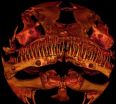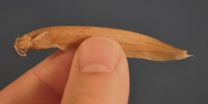(Press-News.org) PHILADELPHIA (May 13, 2014)— Kryptoglanis shajii is a strange fish – and the closer scientists look, the stranger it gets. This small subterranean catfish sees the light of day and human observers only rarely, when it turns up in springs, wells and flooded rice paddies in the Western Ghats mountain region of Kerala, India. It was first described as a new species in 2011.
Soon after that, John Lundberg, PhD, one of the world's leading authorities on catfishes, started taking a closer look at several specimens.
"The more we looked at the skeleton, the stranger it got," said Lundberg, emeritus curator of Ichthyology at the Academy of Natural Sciences of Drexel University and emeritus professor at Drexel in the College of Arts and Sciences. His team's study describing the detailed bone structure of Kryptoglanis is now published in the 2014 issue of the Proceedings of the Academy of Natural Sciences of Philadelphia.
"The characteristics of this animal are just so different that we have a hard time fitting it into the family tree of catfishes," said Lundberg.
From the outside, Kryptoglanis does not look particularly unusual for a catfish. But when Lundberg and his colleagues looked at its bones using digital radiography and high-definition CAT scans, they found some surprises.
Kryptoglanis was missing several bony elements – a characteristic fairly common for subterranean fish. But there were also changes in the shapes of certain bones, changes so strange that Lundberg described them as "completely unique among catfishes and all fishes as far as I know."
Numerous individual bones were modified in the face, giving the fish a compressed front end with a jutting lower jaw – like a bulldog's snout, if a bulldog also had four rows of conical, sharp-tipped teeth.
Multiple changes piled up in one part of the body could mean there is a functional purpose for those changes. "In dogs that was the result of selective breeding. In Kryptoglanis, we don't know yet what in their natural evolution would have led to this modified shape," Lundberg said.
Based on its teeth and subterranean home, Lundberg said that Kryptoglanis most likely eats meat, in the form of small invertebrates and insect larvae – whatever might be found in the groundwater and could be captured by the fish, which at less than ten centimeters is smaller than an adult human's pinkie finger. The fish can move swiftly in its environment, as evidenced by video footage of collected fish darting through water to grab food.
But why Kryptoglanis is so different, and what its closest relatives are, remains a mystery.
Lundberg's team wasn't alone in asking the question. Lundberg's team examined three specimens of Kryptoglanis using digital radiography, and one of these specimens using high-resolution X-ray computed tomography – resulting in detailed, three-dimensional CAT scan images after careful preparation and analysis by Lundberg's colleague and co-author, Kyle Luckenbill, interim collection manager and a research assistant at the Academy. (A video visualization of the fish's internal bony structures is available at http://youtu.be/PBqndwVdnrc.)
At the same time, a separate team led by Ralf Britz at the Natural History Museum of London independently examined the bone structure of Kryptoglanis using a technique of visualizing the skeleton called clearing and staining – a chemical method in which the fish's soft tissues are rendered as clear as glass and bones and cartilage are stained in contrasting colors. This team's description of the structures was published in the March 2014 issue of the journal Ichthyological Exploration of Freshwaters.
"There was an amazing congruence between the results," Lundberg said. "Neither of us was way out."
Neither could figure out which other catfishes Kryptoglanis was most closely related to, although Britz's team chose to assign it to its own new taxonomic family within the order of catfishes.
This fish just one of many unresolved branches on the catfish family tree, in a section where even DNA evidence has thus far proven unhelpful. Subterranean species like Kryptoglanis tend to have dramatically different DNA sequences from one another and from their open-water relatives, making it difficult to identify their evolutionary histories.
"It continues to be a puzzle," Lundberg said.
INFORMATION: END
A tiny, toothy catfish with bulldog snout defies classification
2014-05-13
ELSE PRESS RELEASES FROM THIS DATE:
UTMB study discovers cause of many preterm births
2014-05-13
A new study by researchers at the University of Texas Medical Branch at Galveston is the first to show that premature aging of the placenta due to oxidative stress is the cause of many preterm births. The study appears today in the American Journal of Pathology.
Researchers took fetal membranes, exposed them to oxidative stress in a lab setting (specifically cigarette smoke extract) and examined whether it caused rapid aging of the placental tissue. It did.
Oxidative stress factors include environmental toxins and pollution and are an inevitable component of normal ...
TB lung infection causes changes in the diversity of gut bacteria in mice
2014-05-13
Johns Hopkins researchers have found evidence in mice that a tuberculosis (TB) infection in the lungs triggers immune system signaling to the gut that temporarily decreases the diversity of bacteria in that part of the digestive tract.
The Johns Hopkins researchers showed that this decrease in diversity of gut bacteria as measured in fecal samples happened quickly — within six days after mice were exposed to an aerosol mixture of M. tuberculosis, the TB bacteria. This prompt shift in diversity, they say, suggests that the immune system is attacking the gut bacteria, decreasing ...
Get it over with: People choose more difficult tasks to get jobs done more quickly
2014-05-13
Putting off tasks until later, or procrastination, is a common phenomenon – but new research suggests that "pre-crastination," hurrying to complete a task as soon as possible, may also be common.
The research, published in Psychological Science, a journal of the Association for Psychological Science, suggests that people often opt to begin a task as soon as possible just to get it off their plate, even if they have to expend more physical effort to do so.
"Most of us feel stressed about all the things we need to do – we have to-do lists, not just on slips of paper ...
Coral reefs are critical for risk reduction & adaptation
2014-05-13
ARLINGTON, Va — Stronger storms, rising seas, and flooding are placing hundreds of millions people at risk around the world, and big part of the solution to decrease those risks is just off shore. A new study finds that coral reefs reduce the wave energy that would otherwise impact coastlines by 97 percent.
"Coral reefs serve as an effective first line of defense to incoming waves, storms and rising seas," said Dr. Michael Beck, lead marine scientist of The Nature Conservancy and a co-author of the study, "200 million people across more than 80 nations are at risk if ...
New stem cell research points to early indicators of schizophrenia
2014-05-13
LA JOLLA—Using new stem cell technology, scientists at the Salk Institute have shown that neurons generated from the skin cells of people with schizophrenia behave strangely in early developmental stages, providing a hint as to ways to detect and potentially treat the disease early.
The findings of the study, published online in April's Molecular Psychiatry, support the theory that the neurological dysfunction that eventually causes schizophrenia may begin in the brains of babies still in the womb.
"This study aims to investigate the earliest detectable changes in the ...
Preschool teacher depression linked to behavioral problems in children
2014-05-13
COLUMBUS, Ohio – Depression in preschool teachers is associated with behavioral problems ranging from aggression to sadness in children under the teachers' care, new research suggests.
The study identified one contributing factor to this link: a poor-quality atmosphere in the child care setting that exists as a result of the teacher's depressive symptoms. In this study, "teacher" refers to both classroom instructors and in-home child care providers.
Researchers conducted the study using data from a large national study that collected family information primarily from ...
Odd planet, so far from its star...
2014-05-13
This news release is available in French.
A gas giant has been added to the short list of exoplanets discovered through direct imaging. It is located around GU Psc, a star three times less massive than the Sun and located in the constellation Pisces. The international research team, led by Marie-Ève Naud, a PhD student in the Department of Physics at the Université de Montréal, was able to find this planet by combining observations from the the Gemini Observatories, the Observatoire Mont-Mégantic (OMM), the Canada-France-Hawaii Telescope (CFHT) and the W.M. Keck Observatory.
A ...
Autophagic activation with Nimotuzumab enhances chemo-radiosensitivity
2014-05-13
A study which will be published in the May 2014 issue of Experimental Biology and Medicine was aimed at determining whether an EGFR-targeted therapy combined with chemo-radiotherapy can improve local tumor control effectively, compared to cytotoxic agents or irradiation alone. Dr. Haizhu Song and co-workers from Jinling Hospital and the Medical School of Nanjing University in China demonstrated that nimotuzumab could enhance chemo-radiosensitivity by promoting autophagic cell death in esophageal squamous carcinoma (ESCC) cells.
Nimotuzumab is a humanized anti-EGFR monoclonal ...
Distance influences accuracy of eyewitness IDs
2014-05-13
Eyewitness accuracy declines steadily and quite measuredly as the distance increases. Additionally, a good deal of guess work or so-called "false alarms" also comes into play as the distance increases. These findings have implications for the trustworthiness of eyewitness accounts that are used to solve criminal cases. Research led by James Lampinen of the University of Arkansas in the US and published in Springer's journal Psychonomic Bulletin & Review sheds light on the matter.
Eyewitness identification plays a crucial role in approximately 80,000 criminal cases per ...
Follow that fish!
2014-05-13
New findings published by researchers at the New York University Polytechnic School of Engineering are helping to unravel the complex interplay between alcohol and social behavior and may lead to new therapies for mitigating the negative impacts of alcohol use and abuse. Their experiments, published in the current issue of Alcohol: Clinical and Experimental Research, center not on patrons at a local happy hour, but on far simpler creatures: zebrafish.
A team led by Maurizio Porfiri, associate professor of mechanical and aerospace engineering and director of the school's ...




